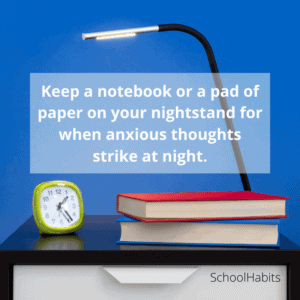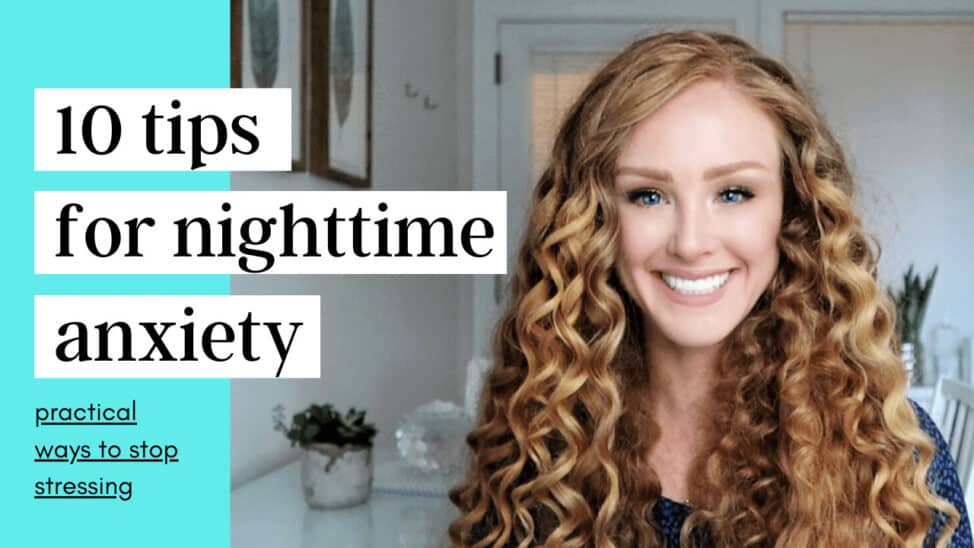By Katie Azevedo, M.Ed.
Anxiety and anxious feelings have a way of appearing at the worst moments, like at night, when we want to sleep.
While it’s normal for our brains to run through events of the day, trying to make sense of our world, our thoughts become an issue when they prevent us from falling asleep. The next time you experience anxiety at night, consider using any or all of the following 10 strategies.
How to handle anxiety at nighttime: 7 tips
The following 10 nighttime anxiety tips are geared towards students, but they will most certainly work for anyone who struggles to shut down their brains at night.
1. Block out anxiety triggers 60-90 minutes before bed.
What constitutes an anxiety trigger is different for everyone, so your job is to observe what activities rattle your nerves and avoid those before bed. Examples of anxiety triggers might include caffeine, social media, the news, video games, texting, movies, and email.
2. Do a brain dump.
If your brain is rattling with a million thoughts before bed, do a brain dump. This is one of my favorite anxiety-reduction strategies. Here’s how to do it.
3. Keep a pad of paper next to your bed.
Keep a simple pad of paper and a pen next to your bed. If you wake up in the middle of the night with a worry, write it down. The simple act of writing something down gives your brain subconscious “permission” to let it go.

4. Organize your morning the night before.
Most anxious thoughts stem from feelings of lack of control. Regain a feeling of control by taking a few minutes before bed to set yourself up for the morning: plan and prep breakfast, pick out your clothes, pack your backpack or work bag, and plan the first hour of your morning.
5. Listen to a guided sleep meditation.
There are free meditation apps and YouTube meditations that are designed specifically for lulling you to sleep. I love this one by Tara Brach. Another option is “sleep stories.” Many of the meditation apps, like Calm, shut off when the meditation is over, so you won’t have to worry about closing down your phone if you fall asleep during the meditation.
6. If you’re anxious about a test, accept it.
What I mean by this is that if you’re anxious about a test, it’s likely because you don’t feel prepared. If you’re not prepared for a test, then of course you’re not going to feel great the night before. If this is the cause of your anxiety, then you have 2 choices:1) prepare more (which isn’t always possible if it’s late at night) or 2) accept that you’re not prepared and accept the consequences. No use in worrying about something that’s too late to control. Do better next time. Here are 7 tips for preventing test anxiety.
7. Read something non-triggering.
You likely already know that reading is a great way to take our minds off of worrisome thoughts, but the key is to ensure that what you’re reading isn’t going to worsen your anxiety. If you’re triggered by scary things, don’t read a horror story before bed. If you’re deeply empathetic, don’t read a sad story before bed. Know yourself and read something that you personally consider neutral.
8. Make a list of 10 things that make you happy.
Simple strategy. Grab a piece of paper (real paper, from a tree) and write down 10 things that make you happy. Spending even just 5 minutes on this exercise can disrupt your spiraling anxious thoughts and release endorphins that calm your nervous system (which will help you sleep).
9. Reframe your anxious thoughts as basic physical symptoms.
Instead of thinking, “Oh no, I have so much to do tomorrow,” identify how this thought is showing up in your body. Is it giving you a stomach ache? A headache? A tense neck? Replace thoughts of “I’m so stressed out” with “my heart is beating really fast.” This simple practice can take the power out of your negative thinking.
10. Do a body scan and muscle release.
Starting from the tips of your toes, working your way up to your head, clench and hold one muscle at a time for 5-7 seconds before releasing it and moving to the next muscle. Here are the exact steps and which muscles to hold. This exercise works because not only does it change your blood chemistry (due to the muscle contraction and hold), but it also requires concentration and focus. When you use your cognitive energy to think about which muscles to clench and for how long, you disrupt your negative and anxious thinking patterns.
Anxious thoughts at any time are no fun, but anxiety at night time can disrupt your sleep, which can make your anxiety worse, which puts you in an unhealthy cycle. If you experience symptoms of anxiety on most days of the week, in many contexts, consult a medical professional.

